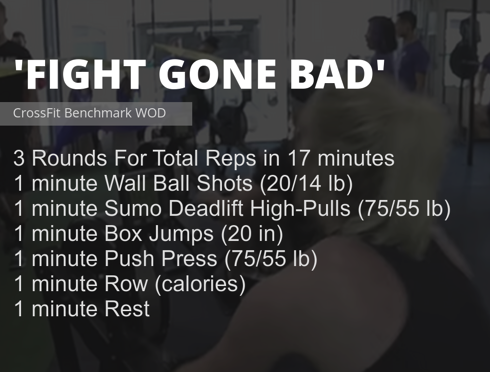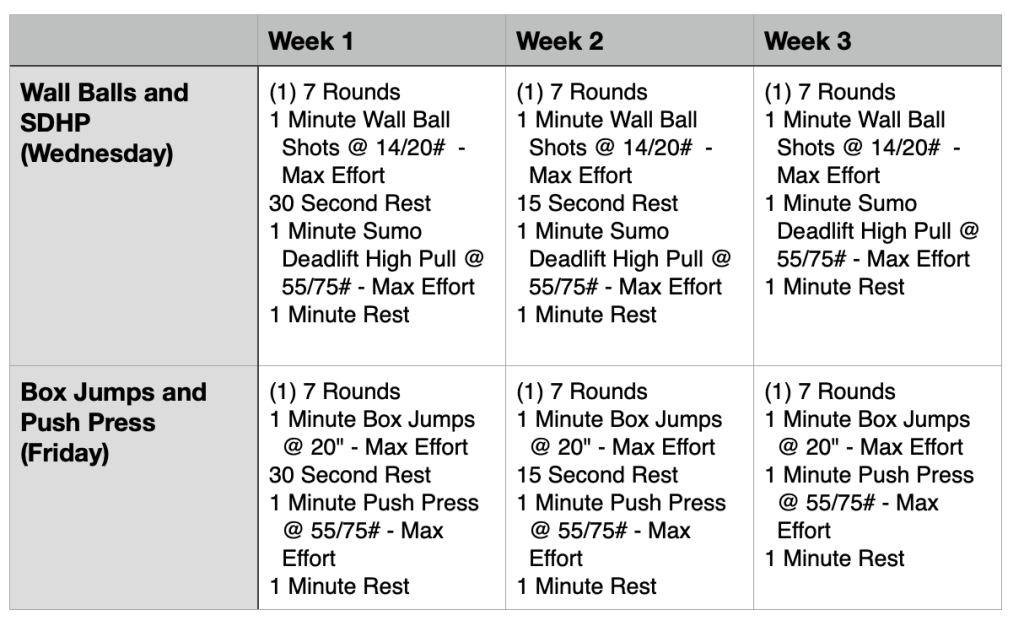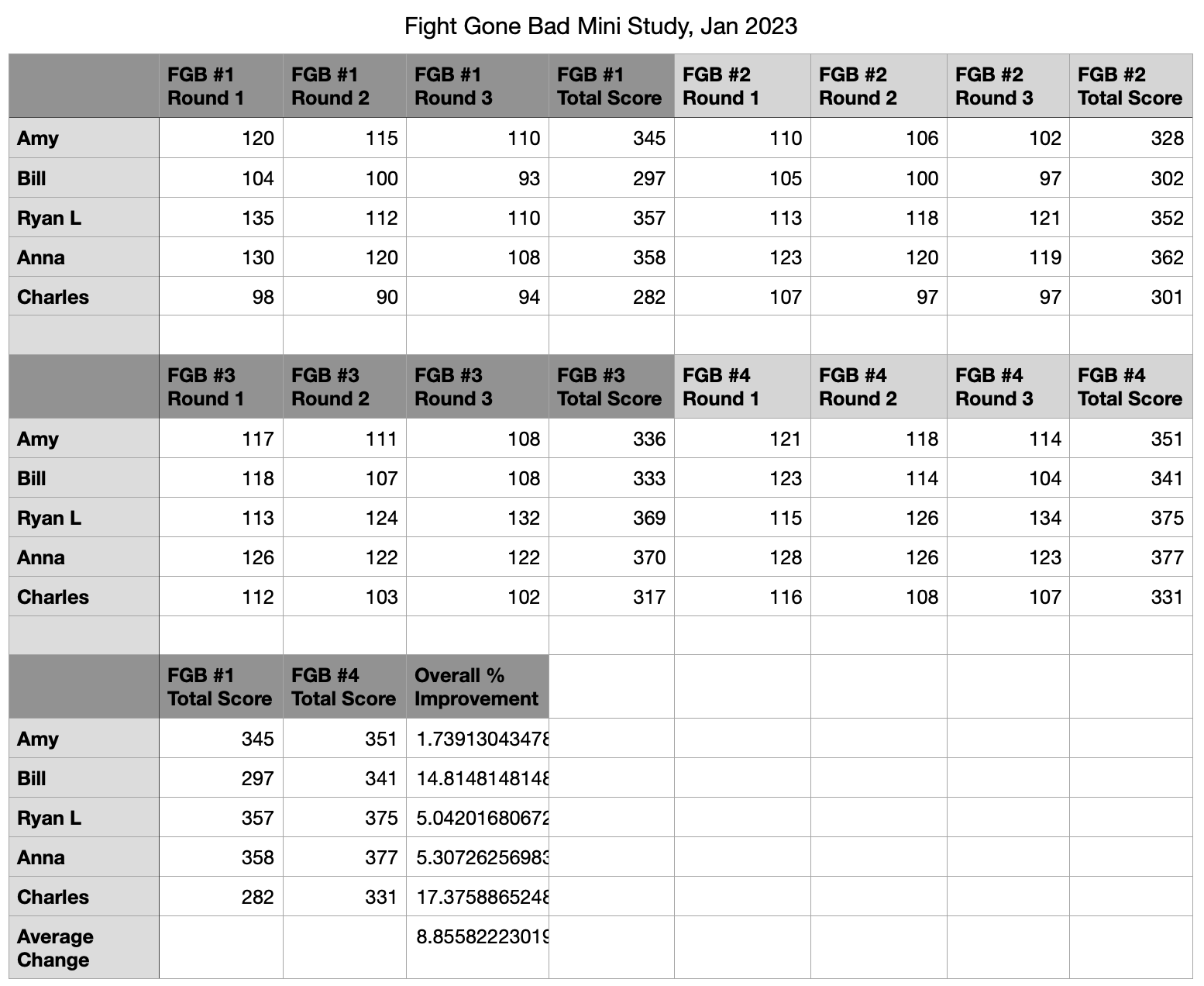
By Rob Shaul, Founder
BLUF
Remote, well-trained, MTI Lab Rats achieved an average 8% overall score increase on the CrossFit “Fight Gone Bad” WOD following event-specific program design.
Background and Study Design
A handful law enforcement agencies around the country use three rounds of “Fight Gone Bad” (FGB) as an annual fitness assessment. We’ve been asked to develop programming to train for this event – which is the reason behind this Mini-Study designed to test classic MTI, event-specific programming for this unique fitness event.
Five veteran and fit, remote MTI Lab Rats completed this 3.5 week Mini Study which began with a full Fight Gone Bad assessment.
Then, for the next three weeks, each group completed the same FGB-specific. progression methodology. Below was the weekly schedule:
- Mon: Fight Gone Bad Assessment – this was done each Monday during the study, 4 weeks in a row
- Tue: 10-12 minute sprint-based work capacity, followed by a moderate pace 30-minute run
- Wed: Interval work for Wall Ball and Sumo Deadlift High Pull (SDHP). 15-Minute Moderate-pace Row on rowing erg
- Thu: 10-12 minute sprint-based work capacity, followed by a moderate pace 30-minute run
- Fri: Interval work for Box Jump and Thrustrer. 15-Minute Moderate-pace Row on rowing erg
The programming scheduled the full Fight Gone Bad assessment every Monday – so the lab rats completed this 4 weeks in a row, and the initial and final FGB scores were compared.
The interval programming progression deployed for the Wall Balls and SDHP (Wednesday) and the Box Jump and Thrusters (Thursday) was time, and not assessment based.
Below is the interval progression deployed. You can see the rest period separating the two exercises declined as the cycle advanced.

In addition to this progression, the lab rats completed a full FGB assessment on Mondays.
My reasoning for the full FGB assessment on Mondays was to familiarize the athletes not only with the event, but also allow them time to develop a completion strategy. For example, one strategy experienced CrossFit competitors deploy for FGB is to only row hard for 30 seconds of the 60-second rowing interval each round … and to rest the remaining 30 seconds. This is simply because calories are counted for scoring on the rowing event, and they are relatively “slow” to score. It’s generally better strategy to rest for half the row and save energy for the easier to score events like wall balls, box jumps and push presses.
Concerning the interval progression for the wall balls/SDHP and box jumps/push presses, in general I like to deploy assessment-based progressions, but for this study I deployed a time-based progression. The difference? Take wall balls for example, using an assessment-based progression, I would have prescribed the athlete a specific number of wall balls they had to score during each work interval, and this number would have been based on their actual individual wall ball scores by round during the full FGB event.
I didn’t use this approach for this study because I made the assumption that most of the lab rats, and the officers completing the study would not have a helper alongside scoring their individual event totals for each round. They would need to keep score themselves and the easiest way to do so would be to keep a running total.
Results & Discussion
See results below:

Overall I was somewhat disappointed in the level of improvement the lab rats achieved during the course of this study. Going in I expected to see at least a 10% average improvement. So why just 8%?
I have a couple theories:
- I didn’t use an assessment-based progression. Doing so would have forced the lab rats to push during each individual event interval on Wednesdays and Fridays. I did this assuming that the athletes wouldn’t keep individual event scores while grinding through FGB – but most did – and I could have used that information for the progressions.
- Overtraining – my lab rats, who are all veterans and fit, seemed to have more issues recovering from this cycle the the many others we’ve done in the past. In hindsight, I could have easily cut the Tuesday and Thursday sprint-based work capacity efforts and just had them do an easy recovery run.
Next Steps
Based on these results, as I design our plan for this event, I’ll implement the assessment-based progression discussed above, as well as cut the Tuesday and Thursday sprint-based work capacity – to allow for more recovery.
Comment below or send your questions/feedback to rob@mtntactical.com
STAY UPDATED
Sign-up for our BETA newsletter. Training tips, research updates, videos and articles - and we’ll never sell your info.
